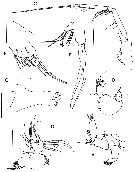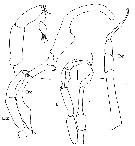|
|
 |
Fiche d'espèce de Copépode |
|
|
Calanoida ( Ordre ) |
|
|
|
Clausocalanoidea ( Superfamille ) |
|
|
|
Diaixidae ( Famille ) |
|
|
|
Vensiasa ( Genre ) |
|
|
| |
Vensiasa sp. Markhaseva, 2015 (F,M) | |
| | | | | | | Ref.: | | | Markhaseva, 2015 (p.190, Descr. F,M, figs.F,M) |  Issued from : E.L. Markhaseva in Proc. Zool. Inst. RAS, 2015, 319 (2). [p.191, Fig.6]. Male (from 28°00.9'S, 07°17.9'E): A-B, habitus (dorsal and lateral, respectively); C, rostrum (lateral); D, posterior prosome and urosome (dorsal); E, posterior prosome, urosome and P5 (lateral); F, right A1 (ancestral segments I-XXI); G, right A1 (ancestral segments XXII-XXVIII). Scale bars: A-B = 0.5 mm; C-G = 0.01 mm. Nota: Prosome 2.6 times as long as urosome. - Rostrum as in female. - Cephalosome and pediger 1, pedigers 4 and 5 separate. - Posterior corners as short rounded lobes. - Caudal rami with 4 terminal plus ventral setae each, dorso-lateral seta was not observed. - A1 reaching posterior border of urosomal somite 4. Right A1 23-segmented.
|
 Issued from : E.L. Markhaseva in Proc. Zool. Inst. RAS, 2015, 319 (2). [p.192, Fig.7]. Male: A, A2; B, Md palp; C, Md gnathobase; D, Mx1; E, Mx2 (proximal praecoxal, coxal and basal endites); F, Mx2 (endopod and enditic-like lobe of proximal endopodal segment); G, Mxp. Scale bars = 0.1 mm. Nota: Oral appendages sexually dimorphic and moderately reduced compared to females.
A2- setation as in female of Vensiasa incerta, except for endopod segment 2 with 12 setae; medial seta of exopod segment 7 placed distally.
- Md mandibular palp armament as in female of V. incerta, except for endopod segment 1 with 2 setaze; basis setae very small, thin.
- Mx1: praecoxal arthrite with 9 terminal spines, 1 posterior seta and 1 anterior seta; coxal endite with 3 setae, coxal epipodite with 7 setae; proximal basal ebdite with 2 setae, distal basal endite with 3 setae; endopod with 5 setae, exopod with 7 setae.
- Mx2: praecoxal endite with 4 setae, coxal, basal endites and enditic-like lobe of proximal endopodal segment with 3 setae each , setae not curved distally. Endopod as in female with 8 sensory setae (6w+2br), 3 terminal worm-like setae longer, 3 proximal worm-like setae short and very thin and 2 brush-like setae (1 thick with well-developed brush and the other thin, with poorly developed brush).
- Mxp: setation of syncoxa and basis as in female of V. incerta, compared to female setae slender; endopod 5-segmented, segment 2 nearly as long as 3 following segments; endopod armament as 4, 3, 3, 3+1 and 4 setae, distal setae more than 1.6 times longer than basis.
P1-P4 in general as in female of V. incerta, except for P1 basis without spinules near the base of medial seta, exopod lateral spines shorter and slender, and P2-P4 posterior spinulation slightly less developed.
|
 Issued from : E.L. Markhaseva in Proc. Zool. Inst. RAS, 2015, 319 (2). [p.193, Fig.8]. Male P5: L left leg; R, right leg; End, endopod; Exp, exopod. Scale bar = 0.1 mm. Nota: P5 nearly as long as urosome; right leg uniramous, coxa and basis separate and together nearly as long as the left basis, exopod segments 1 and 2 incompletely separate; left leg biramous, endopod longer than 3-segmented exopod.
|
 Issued from : E.L. Markhaseva in Proc. Zool. Inst. RAS, 2015, 319 (2). [p.190, Fig.5]. Females in poor conditions (from tropical S Atlantic): A, spermathecae (lateral); B, Md basis (arrow marks distalmost small seta; C, P5. Scale bars = 0.1 mm; A: specimen from 03°57.54'S, 28°03.07'W, between 5170-5181 m. B-C from specimens from 14°58.91'S, 29°56.48'W between 5139-5142 m. Nota: Habitus and rostrum as Vensiasa incerta- Prosome 3.6-4.6 times as long as urosome. - Spermathecae mostly as V. incerta , however, in some specimens relatively shorter and wider. - A1, Mx2 and Mxp as in V. incerta- Md as in V. incerta, except relatively small distalmost seta of the basis. - Mx1 as in V. incerta, except distal basal endite bearing 2 or 3 setae. - P1-P4 as in V. incerta, except one specimen having a longer lateral spine of P1 en exopodal segment 1, reaching the base of spine of succeeding exopodal segment 2. - P5 as in V. incerta, except one specimen having a relatively shorter lateral spine-like unarticulated extension.
| | | | | NZ: | 2 | | |
|
Carte de distribution de Vensiasa sp. par zones géographiques
|
| | | | Loc: | | | SE Atlant.
Type locality: 28°009' S, 07°17.9' E. | | | | N: | 1 | | | | Lg.: | | | (1186) F: 2,1-2,6; M: 2.65; {F: 2,10-2,60; M: 2,65} | | | | Rem.: | Above the sea bed at depths: 5062-5057 m; 5053 m; 5139-5142 m; 5170-181 m.
Females in poor condition. The status remains unresolved. The females differ from the type species of Vensiasa in the following characters: 1- smaller size; 2- different shape of spermathecae in 2 females, which is short and wide; 3- Md basis distalmost seta very short in 3 females; 4- mx1 distal basalo endite with 2 setae in 2 females; 5- P1 exopod segment 1 lateral spine reaching the base of spine at exopodsegment in 1 female; 6- P5 shorter terminal and lateral spine-like unarticulated extensions in 3 females. The 7 examined specimens differ from the type species and between each other. Their poor shape does not give possibility to speculate wether this is a intraspecific variation od Vensiasa sp., or these specimens belong to a different species.
The male is sexually dimorphic, thus making uncertain its attribution to the type species, described after the female. Its assignment to the species and the definition of its taxonomic status is postponeds until new specimens are obtained. | | | Dernière mise à jour : 05/01/2017 | |
|
|
 Toute utilisation de ce site pour une publication sera mentionnée avec la référence suivante : Toute utilisation de ce site pour une publication sera mentionnée avec la référence suivante :
Razouls C., Desreumaux N., Kouwenberg J. et de Bovée F., 2005-2026. - Biodiversité des Copépodes planctoniques marins (morphologie, répartition géographique et données biologiques). Sorbonne Université, CNRS. Disponible sur http://copepodes.obs-banyuls.fr [Accédé le 05 janvier 2026] © copyright 2005-2026 Sorbonne Université, CNRS
|
|
 |
 |






